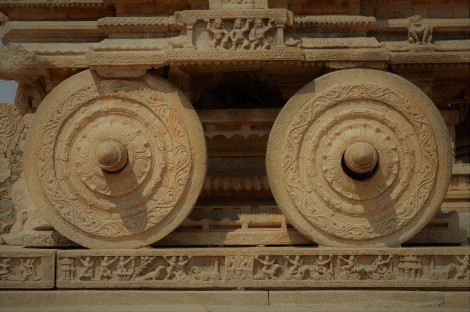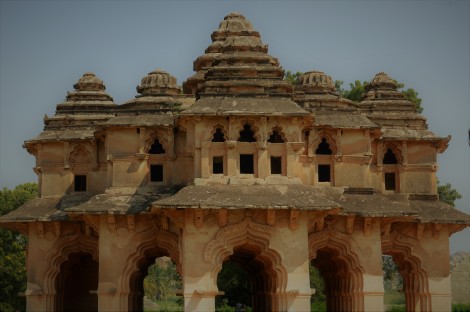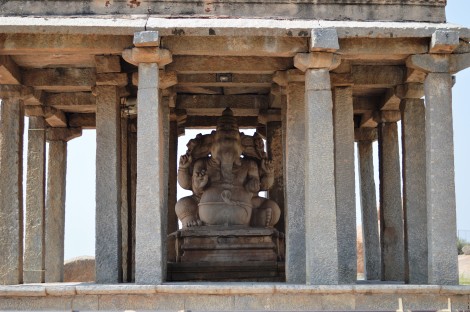Among the giant boulders spread across miles lies the ruins and temples of Hampi which was once the majestic capital of Vijayanagara Empire from from 1343 to 1565 and was said to be the most richest city in the world during the peak of Vijayanagara Empire under King Krishnadevaraya. Hampi, a UNESCO World Heritage Site was traditionally known as Pampa-kshetra. It derives its name from Pampa, which is the old name of the Tungabhadra River.
Hampi is located at a distance of 13 km from Hospet, 374 km from Hyderabad and 35o km from Bengalaru. We did a road trip from Hyderabad to Hampi via Hyderabad – Jadcherla – Bhuthpur – Mahbubnagar – Raichur – Manvi – Sidhnanur – Gangavati – Hospet – Hampi.
What not to miss:
Vittala temple
Vittala temple is the most famous and well-known monument among the ruins of Hampi. The temple is dedicated to Hindu God Vishnu and was built in 15th century AD. The temple work started during the rule of the King Krishnadevaraya but could not be completed and consecrated.
The highlight of Vittala temple is its impressive pillared halls and the stone chariot.
The temple is famous for musical pillars and it is said that when tapped, the pillars used to reverberate music of 81 different music instruments at one point of time.

Vittala temple

Vittala temple musical pillars

Warrior sculpture

Stone pillars outside Vittala temple
The Garuda (eagle) shrine stone chariot
The world famous chariot is located in the Vittala temple and is the most prominent attractions of Hampi. It is actually a shrine build in the form of Vishnu’s stone chariot. The shrine is dedicated to Garuda, the mythical vehicle of Lord Vishnu and once contained the icon on Garuda, though the shrine is empty now. It is said that at one point of time, the wheel actually used to rotate.
The chariot is said to be inspired from the famous Konark Sun temple in Orissa and is one of the three stone chariots in India other being at Konark temple, Orissa and Mahabalipuram,Tamil Nadu.
The excellence of Vijayanagara Empire architecture can be understood from the fact that the chariot looks as if it is a monolithic structure that has been carved out of a gigantic stone. However, in reality it was built using a number of granite blocks of huge size and the joints of the granite blocks were hidden by exceptional carvings.

Garuda stone chariot

Garuda stone chariot front view
One can see two elephants placed before the chariot pulling the chariot. Originally two horses were carved in place of elephants. It appears that the elephants were used to replace the horses when the horses were destroyed.

Wheels of chariot with battle scenes at the bottom
The base platform of the chariot is decorated with scenes from mythical battles.
Lotus Mahal
The Lotul Mahal is another magnificent piece of architecture of Vijayanagara Empire. It was part of the Zenana Enclosure, a secluded area reserved for the royal ladies of the kingdom. The Lotus Mahal is also known as the Chitragani Mahal and Kamal Mahal due to it’s lotus like design.


Lotus Mahal pillars view
Elephant stables
It was used to house the eleven royal elephants in King Krishnadeva Raya’s army.

Elephant stable
Laxmi Narasimha temple
The Ugra Narasimha (means half-man’half-lion ) is one of the incarnation of Hindu God Vishnu.
The Narasimha ( form of Lord Vishnu) is sitting on the coil of a giant seven-headed snake called Sesha Nag. The heads of the snake acts as the hood above his head. It is the largest statue in Hampi. At one point of time there was a temple, now only the statue is remaining. The original statue contained the idol of goddess Lakshmi, consort of the Vishnu, sitting on his lap which was destroyed during the attack and fall of Vijayanagara empire. The hand of goddess can still be seen on the statue.

Ugra Narasimha
Sasivekalu Ganesha temple, Hampi
This temple depicts the Hindu God Ganesha who is famous for his food craving. As per mythology , one day he ate so much of food that his tummy almost busted. He just caught a snake and tied it around his tummy as a belt to save his tummy from bursting. One can see the snake tied around his tummy in the sculpture.

Sasivekalu Ganesha
The Kadalekalu Ganesha
This giant statue of Ganesha was carved out of a huge boulder at the northeastern slope of the Hemakuta hill.

Kadalekalu Ganesh
Stone Doors

Located near the Mahanavami Dibba platform in the Royal Enclosure, the Stone Doors are an impressive pair of monolith doors that were once part of one of the entrances of the Royal Enclosure in Hampi.

Sunset view of Hampi ruins
Tips:
- It is ideal to plan to spend at least 3 days at Hampi to explore the mouments
- One can also explore Badami, Aihole and Padakkal (Badami – Aihole – Pattadakal- A tale of Chalukya era architechture) which is about 140 km from Hampi.
- One can try food at Mango tree restaurant at Hampi which offers good food.

Reblogged this on Third Eye View and commented:
Pictures from Hampi trip posted on https://mytravelsojourns.wordpress.com
LikeLike